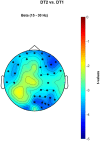Neural Correlates of Single- and Dual-Task Walking in the Real World
- PMID: 28959199
- PMCID: PMC5603763
- DOI: 10.3389/fnhum.2017.00460
Neural Correlates of Single- and Dual-Task Walking in the Real World
Abstract
Recent developments in mobile brain-body imaging (MoBI) technologies have enabled studies of human locomotion where subjects are able to move freely in more ecologically valid scenarios. In this study, MoBI was employed to describe the behavioral and neurophysiological aspects of three different commonly occurring walking conditions in healthy adults. The experimental conditions were self-paced walking, walking while conversing with a friend and lastly walking while texting with a smartphone. We hypothesized that gait performance would decrease with increased cognitive demands and that condition-specific neural activation would involve condition-specific brain areas. Gait kinematics and high density electroencephalography (EEG) were recorded whilst walking around a university campus. Conditions with dual tasks were accompanied by decreased gait performance. Walking while conversing was associated with an increase of theta (θ) and beta (β) neural power in electrodes located over left-frontal and right parietal regions, whereas walking while texting was associated with a decrease of β neural power in a cluster of electrodes over the frontal-premotor and sensorimotor cortices when compared to walking whilst conversing. In conclusion, the behavioral "signatures" of common real-life activities performed outside the laboratory environment were accompanied by differing frequency-specific neural "biomarkers". The current findings encourage the study of the neural biomarkers of disrupted gait control in neurologically impaired patients.
Keywords: EEG; gait monitoring; mobile brain-body imaging; multitasking; neuroimaging; urban environment.
Figures








Similar articles
-
Neural predictors of gait stability when walking freely in the real-world.J Neuroeng Rehabil. 2018 Feb 27;15(1):11. doi: 10.1186/s12984-018-0357-z. J Neuroeng Rehabil. 2018. PMID: 29486775 Free PMC article.
-
Paradoxical improvement of cognitive control in older adults under dual-task walking conditions is associated with more flexible reallocation of neural resources: A Mobile Brain-Body Imaging (MoBI) study.Neuroimage. 2023 Jun;273:120098. doi: 10.1016/j.neuroimage.2023.120098. Epub 2023 Apr 8. Neuroimage. 2023. PMID: 37037381
-
Recalibration of inhibitory control systems during walking-related dual-task interference: a mobile brain-body imaging (MOBI) study.Neuroimage. 2014 Jul 1;94:55-64. doi: 10.1016/j.neuroimage.2014.03.016. Epub 2014 Mar 15. Neuroimage. 2014. PMID: 24642283 Free PMC article.
-
Mobile neuroimaging: What we have learned about the neural control of human walking, with an emphasis on EEG-based research.Neurosci Biobehav Rev. 2024 Jul;162:105718. doi: 10.1016/j.neubiorev.2024.105718. Epub 2024 May 12. Neurosci Biobehav Rev. 2024. PMID: 38744350 Free PMC article. Review.
-
A narrative review of texting as a visually-dependent cognitive-motor secondary task during locomotion.Gait Posture. 2017 Feb;52:354-362. doi: 10.1016/j.gaitpost.2016.12.027. Epub 2016 Dec 22. Gait Posture. 2017. PMID: 28043057 Review.
Cited by
-
Time estimation during motor activity.Front Hum Neurosci. 2023 Apr 21;17:1134027. doi: 10.3389/fnhum.2023.1134027. eCollection 2023. Front Hum Neurosci. 2023. PMID: 37151903 Free PMC article.
-
Dual-task effects of walking-speed on inhibitory control and decision-making under risk.Sci Rep. 2025 Apr 22;15(1):13877. doi: 10.1038/s41598-025-88497-0. Sci Rep. 2025. PMID: 40263305 Free PMC article.
-
Smartphone-Based Answering to School Subject Questions Alters Gait in Young Digital Natives.Front Public Health. 2020 Jun 9;8:187. doi: 10.3389/fpubh.2020.00187. eCollection 2020. Front Public Health. 2020. PMID: 32582605 Free PMC article.
-
Did you even see that? visual sensory processing of single stimuli under different locomotor loads.PLoS One. 2022 May 26;17(5):e0267896. doi: 10.1371/journal.pone.0267896. eCollection 2022. PLoS One. 2022. PMID: 35617315 Free PMC article.
-
Neural predictors of gait stability when walking freely in the real-world.J Neuroeng Rehabil. 2018 Feb 27;15(1):11. doi: 10.1186/s12984-018-0357-z. J Neuroeng Rehabil. 2018. PMID: 29486775 Free PMC article.
References
LinkOut - more resources
Full Text Sources
Other Literature Sources

